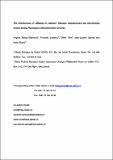Por favor, use este identificador para citar o enlazar a este item:
http://hdl.handle.net/10261/102041COMPARTIR / EXPORTAR:
 SHARE SHARE
 CORE
BASE CORE
BASE
|
|
| Visualizar otros formatos: MARC | Dublin Core | RDF | ORE | MODS | METS | DIDL | DATACITE | |

| Título: | The effectiveness of stilbenes in resistant Vitaceae: ultrastructural and biochemical events during Plasmopara viticola infection process |
Autor: | Alonso-Villaverde Iglesias, Virginia CSIC; Voinesco, Francine; Viret, Olivier; Spring, Jean-Laurent; Gindro, Katia | Palabras clave: | Downy mildew Grapevine Leaf Stilbenes Stomata Resistance Ultrastructure |
Fecha de publicación: | mar-2011 | Editor: | Elsevier | Citación: | Plant Physiology and Biochemistry 49 (3): 265-274 (2011) | Resumen: | Leaves of different Vitis vinifera L. cultivars, susceptible or resistant to downy mildew, Chasselas, Solaris, IRAC 2091 (cvs. Gamaret x Bronner) and Muscadinia rotundifolia were inoculated with Plasmopara viticola. Samples were then examined by scanning and transmission electron microscopy, by light microscopy and for their ability to synthesise stilbenes. These phytoalexins were strictly analysed at infection sites. In the susceptible Chasselas, P. viticola colonises, at 72 h post-infection (hpi), all of the spongy mesophyll with functional haustoria and produces mainly the non toxic piceide. No necrotic zone was observed on Chasselas leaves. The ultrastructural response to downy mildew infection is different in each of the other three resistant grape cultivars. In Solaris, where leaf necrosis are rapidly induced, the infection is restricted to the upper part of the loose spongy mesophyll, and associated with a rapid cell wall disruption and the dispersion of cytoplasmic content along with the production of viniferins. In IRAC 2091, leaf necrosis are quite similar to those observed on Solaris but the infected plant cell, as well as the haustoria, show high electron dense cellular particles without any recognisable organelles, probably related to the effect of the toxic compound pterostilbene, which is synthesised in this grape cultivar. In M. rotundifolia leaf necrosis are much more scarce and smaller than in other cultivars, but pathogen and plant cells are both strongly affected, with concomitant expulsion of cytoplasmic materials through the stomata after P. viticola penetration. In this cultivar, the concentration of all identified stilbenes exceeds 1 × 103 μmol mg−1 FW. The critical role of stilbenes in the resistance of Vitis spp. is discussed. | Versión del editor: | http://dx.doi.org/10.1016/j.plaphy.2010.12.010 | URI: | http://hdl.handle.net/10261/102041 | DOI: | 10.1016/j.plaphy.2010.12.010 | ISSN: | 0981-9428 | E-ISSN: | 1873-2690 |
| Aparece en las colecciones: | (MBG) Artículos |
Ficheros en este ítem:
| Fichero | Descripción | Tamaño | Formato | |
|---|---|---|---|---|
| Alonso_Effectiveness_stilbenes...pdf | 12,64 MB | Adobe PDF |  Visualizar/Abrir |
CORE Recommender
SCOPUSTM
Citations
85
checked on 25-abr-2024
WEB OF SCIENCETM
Citations
82
checked on 11-feb-2024
Page view(s)
296
checked on 28-abr-2024
Download(s)
457
checked on 28-abr-2024
Google ScholarTM
Check
Altmetric
Altmetric
NOTA: Los ítems de Digital.CSIC están protegidos por copyright, con todos los derechos reservados, a menos que se indique lo contrario.
